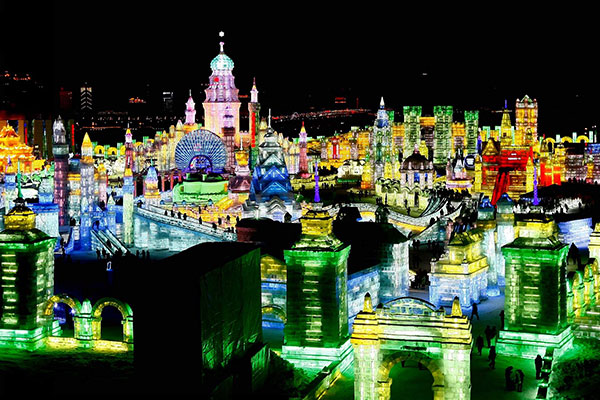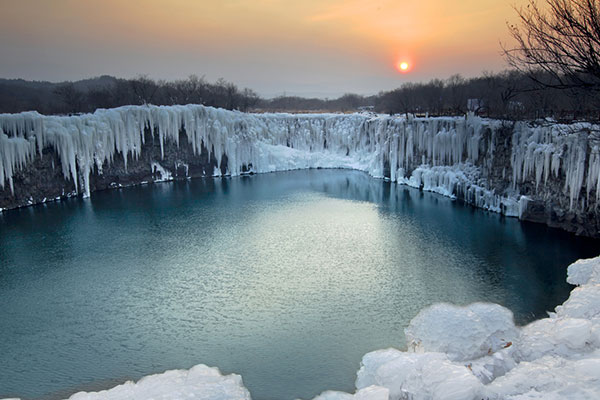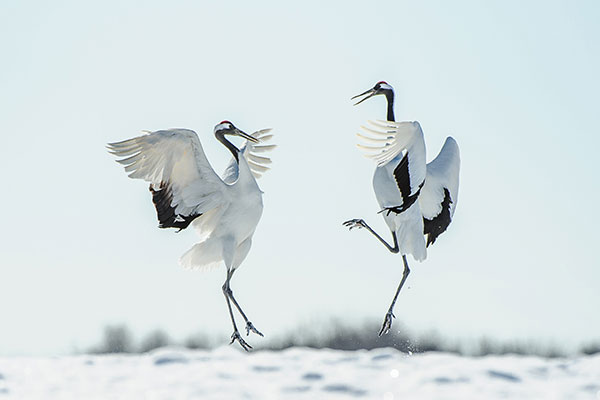
Ice and Snow Amusement World in Harbin, Heilongjiang province.[Photo provided to China Daily]
My upper and lower eyelids were slightly stuck together by the frozen steam from my mouth.
I had to make an effort to open my eyes every time I closed them.
Thin layers of frost emerged over my eyebrows.

Jingbo Lake in the winter.[Photo provided to China Daily]
I could feel the biting cold pressing against my back and trying to get in.
This was what it felt like to be in the open air, 20 degrees Celsius below zero, in Harbin, in China’s northernmost province Heilongjiang.
Yet, the freezing chill was not going to keep me from the winter wonderland.

Frozen waterfall in Jingbo Lake.[Photo provided to China Daily]
Most visitors to Harbin, are drawn to visit by the giant multistory palaces giving off polychromatic glows from within at the Harbin Ice and Snow Amusement World, the snow sculptures at Sun Island and winter sports such as skiing and horse riding on the frozen Songhua River.
Yet, the winter fun there is just the tip of the iceberg with other parts of Heilongjiang offering different winter experiences for tourists to explore.

Houses covered with snow in Xuexiang village.[Photo provided to China Daily]
The province has five classic winter-travel itineraries featuring skiing, hot springs, ice-snow sightseeing and polar region experiences in places like Yabuli, Mohe, Daqing and Qiqihar.
For those like me from southern China who seldom see lots of snow, much less snow-ice-themed art, Heilongjiang does have a certain charm.
Major tourist sites in the city, including the ice and snow world and Sun Island have experienced a 40-65 percent growth in visits, during the period ending Feb 28, 2015, the Heilongjiang tourism authority reports.

Red-crowned cranes in Qiqihar.[Photo provided to China Daily]
More than 88 million tourists visited the province during the first nine months of 2015, representing a 22 percent growth year-on-year.
A unique location endows Heilongjiang with cool summers and stunning winter scenes forged by copious amounts of snow and ice.
Preparations for winter tourism usually kick off with the start of snowfall in December. The snow typically lasts 120 days a year.
Ice digging machines were in operation on the frozen Songhua River and trucks carrying big neatly-carved ice blocks were going past us during my visit at the end of December.
Work on the snow sculptures was under way when I visited Sun Island.
Then, I could see groups of workers standing on snow mounds roughly 20 meters high and sculpting them using shovels. The sight was breathtaking.
It’s hard to imagine how they can use the unwieldy tools to carve those delicate sculptures resembling human faces, animals and European-styled churches and palaces.
Heilongjiang is now going all out to highlight its nature-endowed winter tourism resources with China winning the bid to host the 2022 Winter Olympics.
Focus has been put on integrating sports elements with winter tourism, as the Chinese government expects 300 million Chinese to get involved in winter sports before the Games.
Snowboarding, skiing, snowfield football and marathons have all been planned for and events are being staged all across the province to spice up winter tourism activities.
In particular, special attention is being paid to Yabuli, a place known for skiing. Heilongjiang aims to transform the region into an international winter tourism resort.
The 2,800-meter sliding chute is a perfect site for daredevils. It allows visitors to experience a thrilling ride over 48 twists and turns.
In 2014, Yabuli linked the skiing resources of three mountains, becoming a top-notch ski facility in Asia. Visitors can now use one card to experience 46 tracks spanning a total 50 kilometers across those mountains. Snow tubing and snowmobiles are also available.
As a result, more than 370,000 people visited during the snow season spanning the end of 2014 and early 2015, more than double that of the previous season.
Heilongjiang’s tourism authority’s head, Xi Dongguang says: “We will grow the (winter tourism) industry while introducing China’s unique winter resources to the world.”
Meanwhile, the province joined hands with five Chinese northern destinations to boost ice-snow tourism at the fifth China tourism industry development annual meeting on December 25.
(The meeting also declared the top 10 winter landscape sceneries and the top 10 festive activities in China.)
The province, along with the Inner Mongolia autonomous region, Beijing, and Hebei, Jilin and Liaoning provinces formed an association to promote travel to their locations during the cold months.
Heilongjiang is a good launchpad for other destinations where ice and snow lure tourists, says Xi.
Backing the tie-up, the provincial tourism authority’s deputy director Hou Wei says: “These (six) places all have what it takes to develop winter tourism, but all have different winter tourism products and forms”.
While Inner Mongolia’s winter tourism highlights local minority customs, and tourists can lasso and train horses, and wrestle-all traditional winter pastimes on the grasslands-Jilin integrates skiing with beautiful landscape on the Changbai Mountain.
“The amount of ice and snow used in sculptures or other forms of art in Heilongjiang is unprecedented,” says Hou.
Separately, the association aims to develop a system to integrate and enhance catering, accommodation, shopping and entertainment.
On the accessibility front, the winter tourism routes connecting all the six destinations are expected to be developed in the near future.
For now, Harbin, Liaoning’s Shenyang, and Jilin’s Changchun are all well connected with each other by high-speed rail.
As for roads, highways run all across the province and connect major tourist attractions. Also, well-developed air transportation makes trips to Heilongjiang easy for long-haul travelers.
To date, there are 11 airports connecting the province to major cities across the country as well as Russia and the Republic of Korea, and the US.
At the moment, new airports at Suifenhe, Wudalianchi and Jiansanjiang are being built and are expected to be operational soon.
The new airports will give tourists access to lesser-known but equally exciting places.
“For example, Jiansanjiang is a great place for agricultural tours, and visitors can see modern agricultural practices,” says Hou.
Coming back to my visit, strangely enough, my sensitivity to the freezing cold was blunted by the magnificent polychromatic ice sculptures at the ice-snow world at night.
Some of them were replicas of imposing historical buildings and monuments that are close to if not to scale. They were just more stunning rendered in ice with colorful lights shimmering from within.
And there were mazes and slides fashioned from ice where people were enjoying themselves.
The snow-making machine was still buzzing and preparations were under way to present yet more exciting winter experiences to visitors in January and February.
So, if you are inured spending winter in tropical sites like Sanya in Hainan and want to feel what winter is supposed to feel like, go before spring ultimately delivers Harbin’s ice world’s annual apocalypse.
Top ten winter landscape sceneries
1 Xuexiang village in Heilongjiang province
2 Harbin Ice and Snow Amusement World in Heilongjiang province
3 Jingbo Lake in Heilongjiang province
4 Zhalong nature reserve in Heilongjiang province
5 Wusong Island in Jilin province
6 Changbai Mountain in Jilin province
7 Arxan in Inner Mongolia autonomous region
8 Aoluguya in Inner Mongolia autonomous region
9 Kanas in Xinjiang Uygur autonomous region
10 Beidaihe in Hebei province
Top ten winter festive activities
1 Harbin International Ice and Snow Festival in Heilongjiang province
2 Sun Island International Snow Sculpture Art Expo in Heilongjiang province
3 Daqing snowfield hot spring festival in Heilongjiang province
4 Yichun forest ice and snow festival in Heilongjiang province
5 Winter nadam in Inner Mongolia autonomous region
6 Winter fishing festival at Chagan Lake in Jilin province
7 Jilin international rime festival
8 Snow and ice festival at Bird’s Nest in Beijing
9 Hebei Chongli international ski festival
10 Hot spring in Liaoning province
